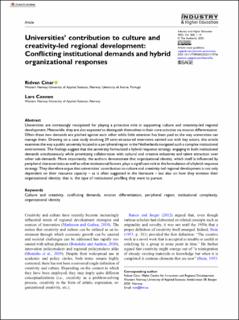| dc.contributor.author | Cinar, Ridvan | |
| dc.contributor.author | Coenen, Lars Martel Antoine | |
| dc.date.accessioned | 2023-03-27T06:13:37Z | |
| dc.date.available | 2023-03-27T06:13:37Z | |
| dc.date.created | 2022-10-19T12:26:45Z | |
| dc.date.issued | 2022 | |
| dc.identifier.citation | Industry & higher education. 2022, . | en_US |
| dc.identifier.issn | 0950-4222 | |
| dc.identifier.uri | https://hdl.handle.net/11250/3060453 | |
| dc.description.abstract | Universities are increasingly recognized for playing a proactive role in supporting culture and creativity-led regional development. Meanwhile, they are also expected to distinguish themselves in their core activities via mission differentiation. Often these two demands are pitched against each other while little attention has been paid to the way universities can manage them. Drawing on a case study involving 29 semi-structured interviews carried out with key actors, this article examines the way a public university located in a peripheral region in the Netherlands navigated such a complex institutional environment. The findings suggest that the university formulated a hybrid response strategy, engaging in both institutional demands simultaneously while prioritizing collaboration with cultural and creative industries and talent attraction over other sub-demands. More importantly, the authors demonstrate that organizational identity, which itself is influenced by peripheral characteristics as well as other institutional factors, plays a significant role in the formulation of a hybrid response strategy. They therefore argue that universities’ contribution to culture and creativity-led regional development is not only dependent on their resource capacity – as is often suggested in the literature – but also on how they envision their organizational identity; that is, the type of institutional profiling they want to pursue. | en_US |
| dc.language.iso | eng | en_US |
| dc.publisher | SAGE Publications | en_US |
| dc.rights | Navngivelse-Ikkekommersiell 4.0 Internasjonal | * |
| dc.rights.uri | http://creativecommons.org/licenses/by-nc/4.0/deed.no | * |
| dc.title | Universities’ contribution to culture and creativity-led regional development: Conflicting institutional demands and hybrid organizational responses | en_US |
| dc.type | Peer reviewed | en_US |
| dc.type | Journal article | en_US |
| dc.description.version | publishedVersion | en_US |
| dc.rights.holder | © The Author(s) 2022. | en_US |
| dc.source.pagenumber | 0 | en_US |
| dc.source.journal | Industry & higher education | en_US |
| dc.identifier.doi | 10.1177/09504222221119736 | |
| dc.identifier.cristin | 2062754 | |
| cristin.ispublished | true | |
| cristin.fulltext | original | |
| cristin.qualitycode | 1 | |

